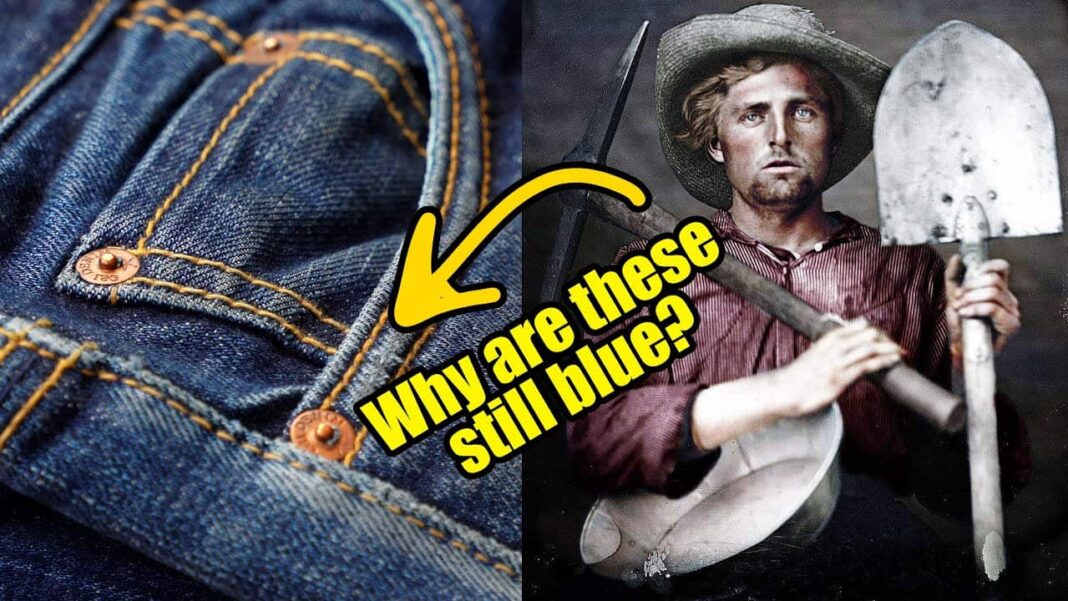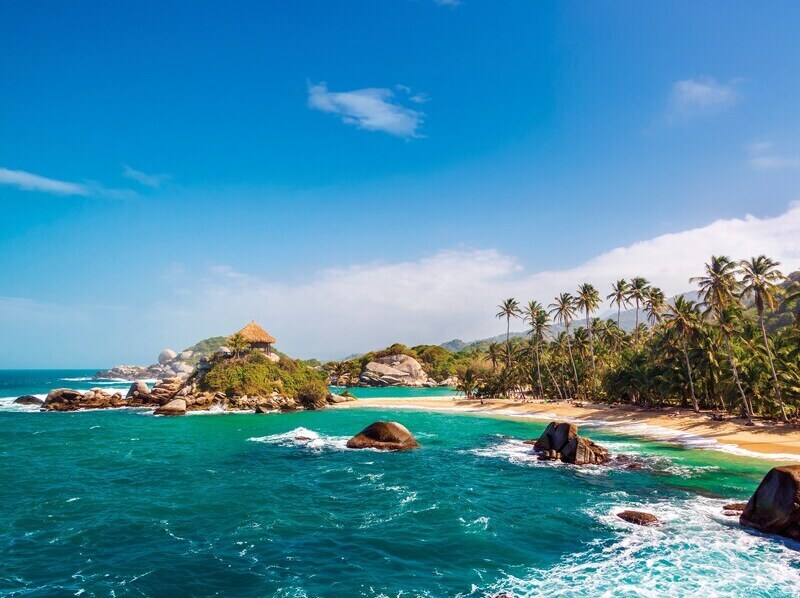
We independently evaluate all recommended products and services. Any products or services put forward appear in no particular order. if you click on links we provide, we may receive compensation.

The Blue Mystery: Why is Denim Blue?
Denim is blue. You probably already know this unless you’re colorblind, in which case you may be thinking, “Oh, I thought it was gray.” Nope, it’s blue. The question today is – well, it’s still blue – why is that so? Let’s get right into it.

Hello everyone! Today, we will answer the age-old question: why is denim blue originally, why was blue picked, and why is it still blue? Because there’s a kind of boring answer and then a more fascinating answer, I figured we could do both.
Understanding Denim’s History

When I say denim jeans, I am talking about riveted denim jeans made by Levi – Levi’s jeans, the first jeans that got really, really popular in the U.S. Denim fabric goes way, way back, or twill fabric goes way, way back. Indigo dye goes way, way back, but Levi has really combined the two in a mass-manufactured way.
There’s a lot of really, really cool reasons why indigo is like this magical dye and has all these cool properties and all these cool things that it does, and then there’s a very, very boring reason as to why indigo was probably used on denim, which is basically the correct answer, but all the other stuff is really cool also.
Expert Insights: Naked and Famous

Special thank you to Bahzad and Risa for helping me make sure all this information is correct. They’re from Naked and Famous. Here’s a sweet message from them.
“Hey everyone, I’m Bahzad, I’m Risa, and we’re from Naked Famous Denim. Thanks for listening to us talk, and thanks for letting us be a part of this article, Michael. We’ll hopefully see you soon.” And by that, they mean going to Japan, which I would love to do, but frankly, right now, I can’t. I have to finish this article, but maybe after.
The Evolution of Blue Jeans
Levi Strauss did not start off with the blue denim jean. Actually, he started off with duck pants that were not blue, and then what happened was Jacob Davis added rivets, and Jacob Davis and Levi Strauss came together, and they made the blue jean. So that’s all you really need to know.
My Gold Rush Theory

So this is the first reason I came up with by myself – I want to absolve Bahzad and Risa from this because it could possibly be the stupidest thing – I think Levi Strauss maybe made them blue because blue looks good when it’s contrasted with the yellow of gold. These jeans were really popular during the gold rush in the U.S., and that definitely may sound stupid.
That’s because it is stupid, and that’s definitely not the reason that he made them blue. You know, maybe he had a little bit of an artistic eye.
The Real Reason: Practicality Wins

Now, the reason denim was a darker color, not necessarily blue, was to help hide stains because the people who were wearing jeans at the time were doing things that weren’t usually very clean.
People regularly would wear suits made of wool and stuff like that, so denim was made to hide stains, be tough, and hang around.
The Science of Indigo

Let’s go over the chemical properties of indigo, which are why indigo was very, very important at the time – still not the full reason as to why it was used, but we’re getting much closer. So the oxidized form of indigo, which is blue, when it’s not oxidized, indigo dye is actually green.
It’s insoluble in water, which helps the color stick to the jeans despite being washed hundreds of times. Other colors at the time would fade too much, and other colors and dyes were also not as UV-resistant as indigo.
So, if indigo was in the sun all day, which is probably where it would be if you’re working outside, it would not fade. It fades for a different reason that we’ll talk about later, which is why denim is still blue today, which is cool.
The Simple Economics

The boring reason why indigo was the color chosen for jeans was because it was the cheapest, most effective dye that Levi Strauss could get, and it was a dark color. See, I told you – not very fun.
But this is a pretty cool thing to read: “Until the introduction of synthetic dyes at the end of the 19th century, indigo was the most significant natural dye known to mankind.” So indigo was basically just the most popular thing at the time.
It wasn’t black, but it was blue, it stayed blue for a really long time, and it was super cheap because it was super abundant.
The Folklore of Blue Jeans

So, anyway, why is denim blue to this day? Because of a few reasons. One of the reasons was because they were so tough that people would be like, “Yeah, I literally pulled Dave’s buggy out of the mud and we used my pants as rope,” and people were like, “You’re kidding!”
They were definitely getting popular just because the strength of them was amazing. The rivets and the jeans really, really made them popular.

Besides the structure of the fabric and the rivets, people were also freaking out about the indigo dye used on jeans. So they were like, “Hey Dave, you know what I heard?” and Dave was like, “No, what’d you hear?” “I heard that indigo is antibacterial, so we can wear our pants longer without smelling and they’ll keep us safer from bacterial diseases.”
“Whoa, you’re kidding! That’s crazy!” “Also, I heard indigo keeps the bugs away from you,” and Dave was still like, “Wow, that’s awesome!” “And also, one more thing – snakes don’t like indigo!”

There’s probably some truth to every single one of those things, but it just kind of created this lore about these pants that are super, super strong, and won’t rip and can pull cars, but they’re also anti-bacterial.
I don’t think that was a very big deal – people in the 1800s were like, “Oh my god, they don’t smell as much when you wear them!” or “They repel bugs, and snakes don’t like them!” Honestly, secretly though, I think the whole they repel bugs thing is just because the denim was so dark that they couldn’t see the bugs. Not that I think people in the 1800s were dumb, but yeah.
From Working Class to Pop Culture

So there was all this like lore and all this crazy stuff about magical denim jeans and riveted jeans and riveted pants and all that stuff. Still, another important factor is it doesn’t seem like this ever changed, but there’s always a very strong admiration for gritty working-class people who wear clothes out.
They get holes and clothes, especially with jeans, which is the biggest thing that we’ll get into in a second.

Everybody else is wearing a suit, and this other guy just came from the gold mines, and he’s filthy and so yucky, and look at him go and my wife thinks he’s cute.
That was also a really big thing, as everybody probably knows. In the 1950s, there was the guy wearing the suit that would go to work that was proper, that looked like a Sears catalog, and then there were the guys that rode motorcycles and cried in movies like James Dean and Marlon Brando and people like that, and those guys wore white t-shirts and blue jeans.
The Technical Marvel of Indigo

But the more important thing is that other colored dyes can’t do what indigo can, which is fascinating, especially in 2022 when I feel like anything can do anything until I need to find out what that anything is, and then it still doesn’t work.
Not a lot of dyes can do what indigo can, and the dyes that can still can’t do it like indigo.

So, really super quick briefing: when you are dying denim – well, I should say this is cotton twill and indigo – indigo dye does not penetrate the fabric. It basically sits on top of the fabric, and denim has a warp and a weft. The warp is on top and blue, and the weft is white and on bottom.
Obviously, you know this if you rip your jeans in certain areas – the weft comes out and puffs up. So that adds a lot of contrast, but the way that indigo dyes denim is that as you wear denim down physically rubbing it together, the indigo itself flakes off and creates very, very high contrast wear, which is what’s so important.

We’ll get into sulfur dyes in a second. Indigo is also really good at not fading when it’s out in the sunlight.
Blue denim jeans are one of the most alive pieces of clothing that you can get next to leather or something that ages over time, which means that people being very curious are like, “Wow, that’s really cool, and these pants are becoming more and more mine every day and like all these holes and rips and fades and stuff because I wore them.”
Modern Alternatives: The Sulfur Question

And you may be asking, “Well, what about sulfur? Well, I’ve heard that canvas can fade.” That’s very true. Sulfur dye is a way of dying things that I feel is the closest to indigo dying, but it’s not quite there yet. Obviously, you can get black jeans that fade to gray – those are dyed with sulfur.
But I asked Bahzad and Risa about this because I figured this would come up, and this is what they said: “Long story short, you can achieve fades with sulfur dyes in different colors, but the fading won’t be nearly as strong as indigo, and it’s very difficult to dye things with sulfur dyes besides black because it’s hard to dye evenly, so you can miss your targeted color for the garment quite easily.”
Watch This Review
Conclusion: The Legacy Lives On
So, anyway, long story short, why is denim blue? It’s culturally significant and it’s really the only dye and fabric combination that completely tells your story in the pants. I would love to tell you my story in the pants next week, sorry!
Real quick – the last thing is Bahzad and Risa were telling me that they’re just people in the industry who have loved denim and indigo for a very long time and worked very hard to keep that alive in the larger mainstream industry as well, so that’s another reason. Anyway, see you later. Thanks for reading!
This article was adapted from Michael Kristy’s video on The Iron Snail, with edits from FashionBeans, and was reviewed by Michael to ensure the integrity of his original content. Watch the full video here.

The Iron Snail is a men’s fashion vlog (and now article series!) starring a young man named Michael and featuring a snail no bigger than a quarter. The two are set on taking over the world of fashion by creating a clothing line to end all clothing lines. Until then, we’re here to tell you EVERYTHING you need to know about the best clothing out there, from the highest quality raw denim jeans to the warmest jackets to the sturdiest boots…the Iron Snail has got you covered.


